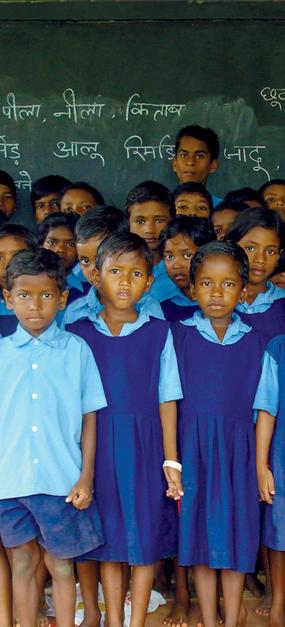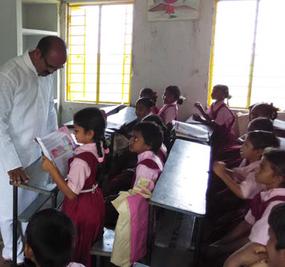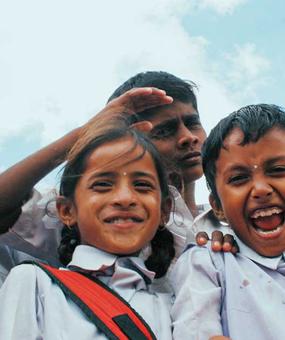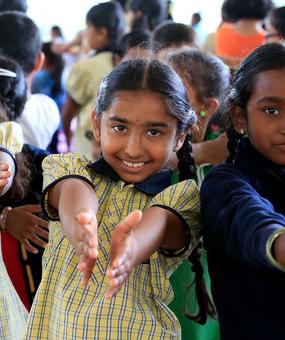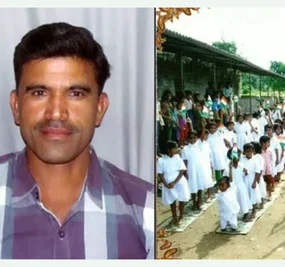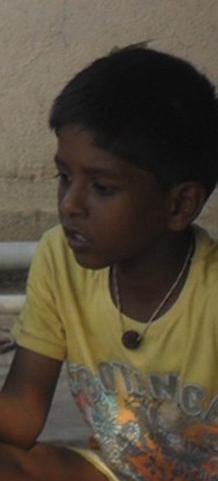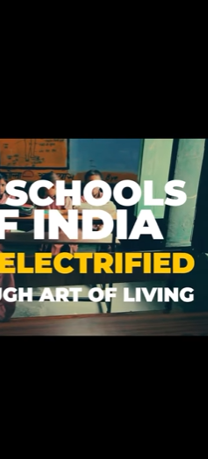Rajaque Rahman and Namita Malik travelled to rural Tripura to document the power of education. And what they saw was this civilization’s greatest leveller being celebrated in the state’s most distant areas, thanks to the Art of Living free schools.
In a world where schools are judged on the number of swimming pools and air-conditioned rooms they have, these may not even be considered ‘schools’. But put them in the context of their surroundings, and they become the only glimmer of hope for the next generation. This is the story of 41 free schools run by the Art of Living in one of the remotest areas of the North Eastern Indian state of Tripura. These schools are not just providing free education to poor children, but also serving as focal points for far-reaching social transformations in the surrounding communities.
“This school has made a significant difference in the lives of the children in this community. Not only have their talents flourished, but they have also grown up to have values. ”. This statement by Amar Singh Jamatia, a local leader in West Kuphilong, South Tripura, where one of the schools is located, echoes the sentiments of locals who benefit from these schools. The 41 schools provide education to 1,855 children across the state. All amenities including uniforms, book, bags and mid-day meals are provided completely free.
Education at Gunpoint
These schools are located in remotest places of Tripura. “Most of these villages of Tripura have remained backward as they were infested by insurgency from 2000 to 2008. Nobody dared to venture into these areas as there were instances of kidnapping and killing,” explains Swapan Patari, an Art of Living volunteer who oversees the functioning of these schools across the state.
Even the Art of Living volunteers had to risk their own lives to work here. Debabrata Banik, who co-ordinates the school project in Tripura, recalls a scary incidence he faced when he was working to open a school in Malsoompara in South Tripura. “I was told to take ‘permission’ from a ‘powerful person of the village’ to start the school. When I went to meet him, he was sitting with an AK47 rifle by his side! That’s when I realised he was a leader of TNLF (Tribal National Liberation Front) which was engaged in an armed movement in the area. After the initial posturing which really scared me, he gave the permission, saying they will not harm anybody who intends to do good for the village.
Teaching them to Dream
More than the gun, it was the parents’ lack of awareness that the Art of Living had to battle to overcome in order to open the schools. The schools are situated in locations where illiterate and landless laborers predominate. Therefore, the parents do not place high importance on their child’s education. When the parents go into the field, many are kids are forced to work in the field or care for their younger siblings. Hence, many kids don’t go to school at all.
Moreover, the state of affairs in other local schools was disappointing for the parents. “Teachers don’t come in the other local schools. The children go there only to eat what is served for the mid-day meal. So we felt no use in sending our children there,” says Manoj Kanti Chiran, a landless laborer and father of two.
In the backdrop of this, convincing the parents to send their children to school hasn’t been an easy task. “Initially, we went house-to-house to convince the parents. They saw no point in sending their children to the local high school which has only six teachers for a total of 14 classes,” explains Budhha Kumar, a 30-year-old Yuvacharya (youth leader) of the Art of Living who oversees the day-to-day running of the school at Gularibari.
“Now this school (Sri Sri Seva Mandir) is providing real education to our children and we can hope for a bright future for them,” he adds patting the back of his son who studies in Class I in Sri Sri Seva Mandir located at Gularibari, West Tripura. This school has given him so much confidence in education that today he dreams of making his son a doctor.
Winning the Hearts
“Our biggest advantage was that the parents listen to us because of the work we have done in the area other than the school, such as medical camps, health and hygiene campaigns,” explains Shamcharan Debverma, another Art of Living volunteer from Gularibari. The people of the area have so much faith in him that they are encouraging him to contest the local body elections.
“Our Nav Chetna Shivirs (rejuvenation camps) which were conducted for the villagers before opening the schools played a major role in changing the mindset. These camps made them realise that education can change their life. Thanks to this new-found awareness among the parents, we have more than 80% attendance and almost zero dropout in all our schools,” says Debabrata Banik. “In many places, we started the school based on demands from the parents,” he adds. “The parents really respect us as teachers and that shows that they now value education of their children,” adds Uttam Debnath, who teaches in the West Kuphilong (South Tripura) school. In Gourangatilla in West Tripura, the parents have become so motivated to educate their children that they have engaged a vehicle to transport their children to the school, shelling out Rs 200 per month. In some schools, one will see 60-year-olds coming from far-off villages to pick up their grandchildren.
This was the best program
Shrikrishna
Equal Partners
Interestingly, it’s the womenfolk that are leading this silent knowledge revolution. In many schools, one could see lines of women waiting for the school to close and take their children home. In some cases, they sit through the whole day just to make sure the children stay in school. But the men are not far behind. In some places, they are making land available, at others they are constructing school buildings themselves, and in some others, they are sponsoring teachers’ training.
In Gourangatilla, the local club has donated the entire land earlier earmarked for itself to Sri Sri Seva Mandir. And in Ishanpur (West Tripura), the school is run in the local club building itself. “This building was constructed for the local club, but the club was of not much use. So we have offered it to the Art of Living to run a school. And today, the school is making a big difference and helping the growth of the locality,” shares Nirmal Das, secretary of New Star Club. In Shantinagar, under Khowai Division of West Tripura, the new school building was constructed with local support.
How do these uneducated parents get the vision that education can change the face of their village and get motivated to even part with their own houses? “After doing YLTP (Youth Leadership Training Programme) of the Art of Living, I met Guruji (His Holiness Gurudev Sri Sri Ravi Shankar) when he came to Arunachal Pradesh in 2008. While addressing a meeting of rural youth which I was attending, Guruji encouraged us to focus on starting free schools in our areas. Inspired by him, I decided to start a school in my village. The biggest problem was finding a suitable building. Finally, I decided to donate my own house. Initially we had very few children, but now we have more than 75 children,” says Sunai Bhaktamal Malsoom of Malsoompara village.
A Class Apart
Every parent is ecstatic about the high quality of education that the Art of Living schools are bringing to Tripura’s countryside. “We don’t have the facilities we hear about in towns, but the standard of education in this school is so good that we feel we live in a developed city,” says Sapna Deb of Shantinagar. This lady has a deep emotional attachment with the school. She was childless for eight years after marriage. Then she did the Art of Living Part I programme and immediately afterwards she got pregnant. Today her daughter is four years old and attending the Art of Living school.
From one village to another, from one school to another, you can always spot a unique transformation. “The children who attend the Art of Living school learn to speak English” says Sataranjan Debverma whose daughter studies in Nursery in the Gularibari school. “The students of this school are different. They are excited to study at home also, as learning has been made interesting by the teachers,” quips Sanjiv Das whose son studies in Class II in the Art of Living school located in Bagabasa, West Tripura.
“The Art of Living has brought quality education to this area,” says Kajalrani Debverma, Panchayat Member of Shantinagar. “Thanks to this school, all the families of the village have access to quality education and that too in English medium which was out of question for the villagers. The overall development of the children is amazing,” concurs Rabindra Dutta, Pradhan of the local Panchayat.
“Here even Class I children can sing the National Anthem whereas the Class VI students of other local schools can’t,” says Amar Singh of West Kuphilong. Many government-run local schools are also improving thanks to the inspiration from the Art of Living free schools. “Many Anganwadi centres in our areas have become active again due to the healthy competition posed by successful Art of Living schools,” observes Samir Mazumdar, a local leader from Kalshi in South Tripura.
The Holistic Lesson
More than just good education, what is moving people’s hearts is the overall growth of the children who attend the Art of Living free schools. “Here apart from good education, overall development of the child is attended to. Art, yoga, and meditation are also taught. The biggest growth is seen in the area of their mannerism and discipline. This is remarkable because these children don’t have a conducive atmosphere at home,” opines Sudangshu Das, a graduate who has been teaching for last four years in the Gourangatilla school. He cites this far-reaching transformation as the reason for him working in the school despite having to work longer hours for lesser salary. He isn’t alone to be inspired to walk the extra mile for a brighter future of Rural Tripura.
Pranab Mandy who teaches in the Malsoompara school, for one, cycles 20 km every day. “The children here are getting a lot more exposure in a stress-free environment,” adds Sudangshu. And that exposure is showing. “I retired after 35 years of teaching in another local school. But I couldn’t bring about the kind of transformation children here are witnessing. The level of education is much higher and mannerism is different. Here children are learning to take responsibility for themselves,” notices Sushil Chandra Deb, who is in-charge of the Gourangatilla school.
Extracurricular Payoffs
These schools encourage the mixing of different communities and cultures. Most of the schools have mix of students from tribal communities, Bengali Hindus and Bengali Muslims. “Earlier these communities lived in segregation. This school is doing a great job of uniting the different communities. Look at them. You will find people from all communities,” says Subrata Acharya, a committee member of the school at Garjee in South Tripura, pointing to the line of ladies who have come to collect their children. Burqa-clad and Hindu women chatting congenially with each other stood out as a testimony to his claim.
Health and hygiene is another area where these schools are revolutionising Rural Tripura. Routine medical check-ups are held to ensure health of not only the children but also the parents. “We have benefited a lot from the medical camps,” testifies Bithi Rai, whose daughter studies in the Garjee school. In Kalshi, the school organised Hepatitis vaccination for all the children, their parents and other villagers. “This school is acting as a rallying point for health and hygiene in the area. Thanks to the exposure, the villagers are becoming more receptive of our health and hygiene campaigns in the area,” reasons Nandalal Bhowmik, a Yuvacharya working in the area.
There is also an economic upside to this story of grassroots revolution unfolding in Tripura. These schools are not only providing free education, but also translating into savings for the parents. “If we want to send our children to a good school, we will need to spend at least Rs 50 a day in transport. This school is helping us save that money,” calculates Jayanta Mazumdar, a small-time insurance agent whose daughter is studying in the school in Kalshi. Most of Art of Living schools are located in places where the closest private school is at quite a distance, hence commute to these schools is cheaper.
Empowering the Communities
Not only children but also elders are getting empowered. “After doing the Art of Living workshop, I felt so confident of my abilities that I am able to teach in the village school now. Though I studied up to secondary level from the government school, I was not confident to do anything on my own. But, now I am teaching in the school,” testifies Reshma Debverma, a teacher in the Gularibari school. Shanti Rai of Malsoompara is another. She got opportunity to study up to Class IX only. “I was determined to make sure that the children of my village don’t suffer because of lack of opportunities. So when the Art of Living opened the school, I decided to teach in this school.”
These ladies may not be Sunita Williams; yet their achievements are no less. They have broken the social barriers and have come this far in a society where education had no place until recently.
Truly, education can change lives. Whoever said education is this civilization’s greatest leveller, must have done so after visiting the Art of Living free schools in Tripura!
Text by M Rajaque Rahman; Photo by Namita Malik



